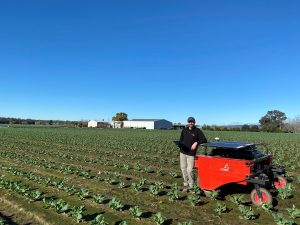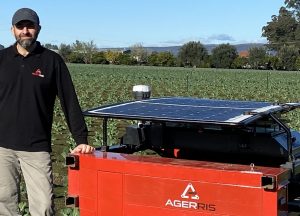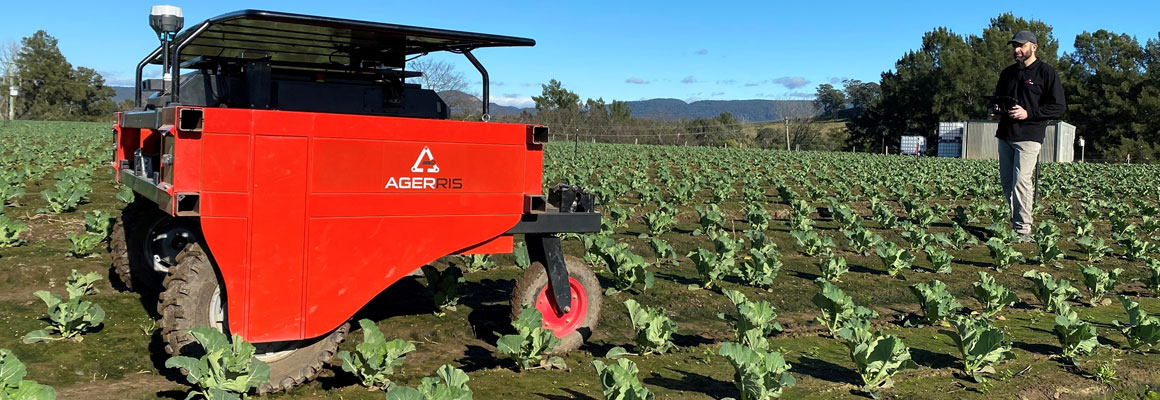Catching up with… Professor Salah Sukkarieh
Works at: Agerris (CEO) and the Australian Centre for Field Robotics, University of Sydney (Professor of Robotics)
Hi Salah, thank you for taking the time to chat to us!
Firstly, can you please give us an overview of your work. What are your main focus areas?
My work revolves around the research, development and commercialisation of robotic and AI technology for on-farm operations. It involves continuously looking ahead 5-10 years with growers and determining the right technology roadmap that will meet their present and future needs; building and demonstrating the technology with grower input; and determining the most efficient and cost-effective way of commercialising the technology to get it on-farm.
My main focus is on how we can bring together mobile robotic platforms – with AI and intelligent tools – in a low-cost and easy to use platform for growers across the whole vegetable sector. It’s a big ask, but we have the technology and the grower support to be able to achieve this.
What are you working on at the moment?
There are three parts at the moment. The first is the commercialisation of The Digital Farmhand. This is an intelligent solar-electric mobile robot for the vegetable industry that can do real-time mechanical weeding (better than a chippy), per plant spraying, and yield/count/health crop intelligence.
The second is extending the capability of The Digital Farmhand for other on-farm labour tasks that either support or undertake autonomous selective harvesting.
The third is developing an Ag Robotics STEM course for rural schools, where we use a simpler form of the same on-farm robot to teach school kids about the technology and help close the digital divide that we believe will, in-turn, help growers.

How did you get to where you are today?
I led a large research and commercialisation lab for 20 years at the University of Sydney where we collaborated with a number of Australian and international industry partners in building their autonomous operation capabilities. Examples include the autonomous mining operations with Rio Tinto, the intelligent flight planning system for Qantas, and the automation of straddle carriers for Patrick Stevedores.
Simultaneously I had a desire to see how the same type of technology could be used to support environment stewardship. It started about 15 years ago with the building and flying of drones for MLA to detect woody weeds, which naturally got me talking to growers from a wide range of sectors and seeing the wide variety of pain points.
This drew me towards ground robotics. Philanthropy and MLA funding supported research into a grazing livestock ground robot; Hort Innovation with the almond and apple industry-funded ground robotic project for crop intelligence, and Hort Innovation again, through the vegetable research and development levy, funded a ground robotics program for the vegetable industry. In 2019, the University received external VC investment to commercialise the technology and get it into the growers’ hands – which is where I am now.
Tell us – what do you enjoy most about your job? What are your career highlights?
Its great talking to growers as they are professional systems thinkers that have to capture the physical, biological and chemical characteristics of the environment. It gels well with the systems thinking of field roboticists who have to bring together mechanical, electronic and software together to make a system work in field. The conversations between the two groups is always exciting and positively challenging. Bringing these ideas together into a new and novel frontier that will help build a sustainable Australian agriculture industry is absolutely energising.
There have been a few career highlights across different industry sectors but being part of the transformational thinking and application of agriculture robotics to the horticulture sector over the last decade has been the most rewarding.

In terms of robotics, what areas would you like to see develop across the vegetable sector?
The robotics and AI technology is available and there is desire and interest from growers to have it on-farm.
In the short term, I see many positive outcomes. For the long term, I feel that it is important to rethink business models, infrastructure, and people, in order to build a local and sustainable vegetable robotics industry that will continue to help growers.
As for business models, we could be asking how to best capitalise on technology that has both a labour and agronomy operational benefit across the whole production lifecycle. The classic buy/lease/own concept may not be the right way forward for a constantly evolving technology piece that will help solve many of the on-farm operational needs.
As for infrastructure, the vegetable sector could ask how to best setup farm operations to make it easier to introduce robotic solutions that will support high precision farming across the whole production cycle. There is the potential to not only have simple robotic tools on farm doing weeding and pest detection, but also more complex autonomous systems that selectively harvest crops.
As for people, the vegetable sector could look at what is required to capitalise on the various industry and government activities around high-school STEM that will help build the human capital for a rapidly evolving technology.
They say kids love three things – dinosaurs, space, and robotics. By getting in early with high school students and showing how robotics is helping change agriculture, we are already seeing how the view of agriculture is changing to one showing a bright and promising future for a career.
Where can we find out more about your work?
At the Agerris website.
On the Agerris LinkedIn page.
Australian Centre for Field Robotics – University of Sydney website.
Videos of previous work:
Search “ACFR ag robotics playlist” on YouTube or click here.

